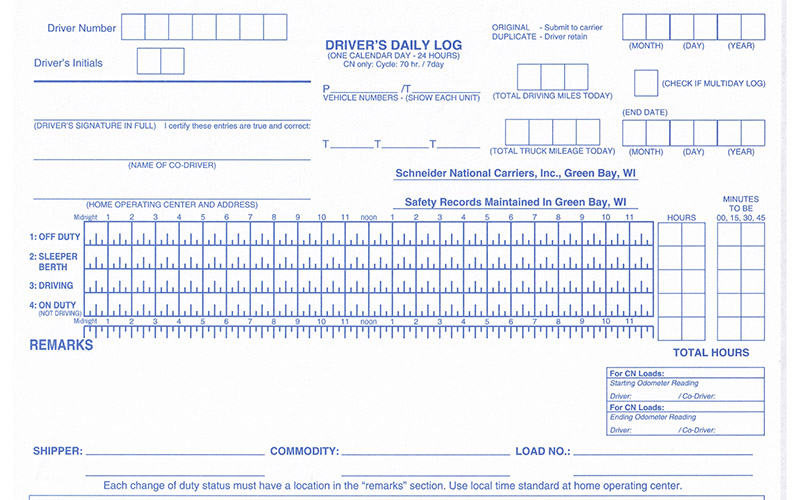What is a log book for truckers? A comprehensive guide


By The Schneider Guy
Estimated reading time: 3 minutes
An integral part of a truck driver’s job responsibilities is keeping an accurate record of their driving activities. Traditionally, this was recorded in a paper log book, and over time, truck drivers have transitioned to using electronic logging devices (ELDs)
Let’s dive into what a log book is for truckers and why it is so important.
What is a log book for truckers?
A log book for truckers, also known as a driver's log or driver's daily log, is a record-keeping document used by truck drivers to track their:
- Driving activities.
- Hours of Service (HOS).
- Compliance with regulations.
A log book serves as a comprehensive record of a driver's duty status and provides valuable information to regulatory authorities, employers and the drivers themselves.
What is an electronic log book?
In recent years, there has been a transition from traditional paper log books to ELDs. ELDs automatically record a driver's HOS and remove the need for paper entries.
However, it's important to note that while the method of recording may have changed, the purpose and importance of maintaining a log book remain the same.
Do truck drivers still use paper log books?
Truckers still need to keep a paper log book with them even when using an ELD. In the event of an ELD malfunction, truckers are required to switch to a paper log book until the ELD is repaired or replaced.
Drivers must keep at least eight days of paper logs with them at all times.
Why are log books important?
Hours of Service compliance
One of the main reasons for maintaining a log book is to ensure compliance with HOS regulations. These regulations, enforced by the Federal Motor Carrier Safety Administration (FMCSA), determine the number of hours a driver can drive and the minimum amount of rest required.
By accurately recording their activities and breaks, drivers can prove their compliance with these important safety regulations, which helps prevent fatigue-related accidents and promotes road safety.
Documentation and accountability
Log books act as a documented trail of a driver's activities, providing crucial information about their driving and working hours. This documentation can be essential in various scenarios, including:
- Audits.
- Accident investigations.
- Legal proceedings.
When is a log book required?
Truck drivers need to carry a log book if they operate commercial vehicles involved in interstate commerce and meet specific criteria defined by the FMCSA, including:
- They operate a vehicle with a gross vehicle weight rating (GVWR) of 10,001 pounds or more.
- They transport hazardous materials that require placarding.
What does a log book include?

Date: The date is recorded at the top of the log page.
Time: Each log page covers a 24-hour period, divided by vertical lines in the grid area. Each full hour is printed across the top of the grid area, and each hour is broken down into 15-minute increments by short, vertical lines.
Duty status: There are four horizontal rows in the grid area. Each row represents one of the four duty statuses a driver falls under. The four statuses are:
- Off-duty (line one).
- Sleeper berth (line two).
- Driving (line three).
- On-duty not driving (line four).
Remarks: The remarks section below the grid area is where the driver records the city and state of each change in duty status. Along with the city and state, the driver also records specific information about what they were doing, such as:
- Completing a pre- and post-trip inspection.
- Doing Enroute inspections.
- Loading and unloading freight.
- Changing trailers.
- Fueling the truck.
Learn how to fill out a paper log book.
Check out this detailed explanation and walkthrough from a Schneider Driver Instructor.

Schneider Guy loves the "Big Orange." He's passionate about the trucking industry and connecting people to rewarding careers within it. He's been the eyes and ears of our company since our founding in 1935, and he's excited to interact with prospective and current Schneider associates through "A Slice of Orange."



